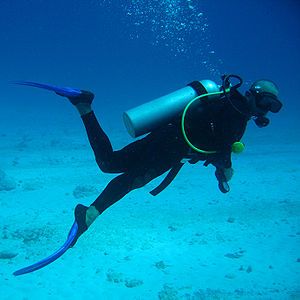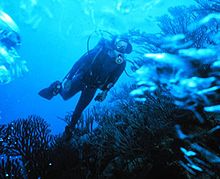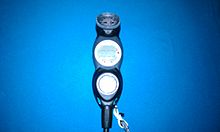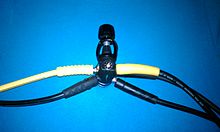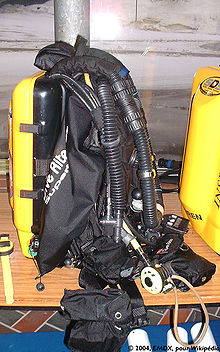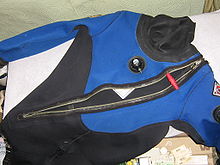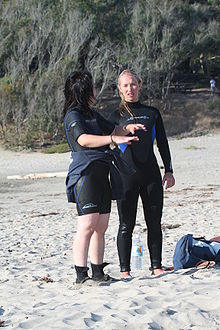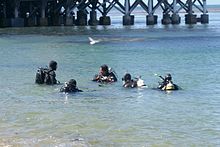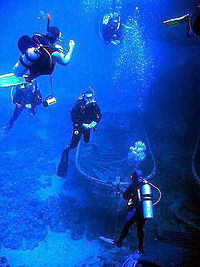- Scuba diving
-
Not to be confused with Self-contained breathing apparatus, which describes breathing sets used out of water.
Scuba diving ("SCUBA" originally being an acronym for self contained underwater breathing apparatus, now widely considered a word in its own right)[1] is a form of underwater diving in which a diver uses a scuba set to breathe underwater.[2]
Unlike early diving, which relied either on breath-hold or on air pumped from the surface, scuba divers carry their own source of breathing gas (usually compressed air),[3] allowing them greater freedom of movement than with an air line. Both surface supplied and scuba diving allow divers to stay underwater significantly longer than with breath-holding techniques as used in snorkelling and free-diving. Depending on the purpose of the dive, a diver usually moves underwater by swimfins attached to the feet, but external propulsion can come from an underwater vehicle, or a sled pulled from the surface.
Contents
History
Main article: timeline of underwater technology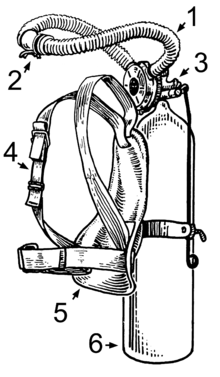 Original Aqualung scuba set.
Original Aqualung scuba set.
1: Air Hose, 2: Mouthpiece, 3: Regulator, 4: Harness, 5: Back plate, 6: TankThe first commercially successful scuba sets were the Aqualung open-circuit units developed by Emile Gagnan and Jacques-Yves Cousteau, in which compressed gas (usually air) is inhaled from a tank and then exhaled into the water adjacent to the tank. However, the scuba regulators of today trace their origins to Australia, where Ted Eldred developed the first mouth piece regulator, known as the Porpoise. This regulator was developed because patents protected the Aqualung's double hose design. It separated the cylinder from the demand valve giving the diver air at the same pressure surrounding his mouth, not surrounding the tank.
The open circuit systems were developed after Cousteau had a number of incidents of oxygen toxicity using a rebreather system, in which exhaled air[citation needed] is reprocessed to remove carbon dioxide. Modern versions of rebreather systems (both semi-closed circuit and closed circuit) are still available today, and form the second main type of scuba unit, most commonly used for technical diving, such as deep diving.
Etymology
The term "SCUBA" (an acronym for self-contained underwater breathing apparatus) arose during World War II, and originally referred to United States combat frogmen's oxygen rebreathers, developed by Dr. Christian Lambertsen for underwater warfare.[3][4][5]
The word "SCUBA" began as an acronym, but it is now usually thought of as a regular word—"scuba". It has become acceptable to refer to "scuba equipment" or "scuba apparatus"—examples of the linguistic RAS syndrome.
Types of diving
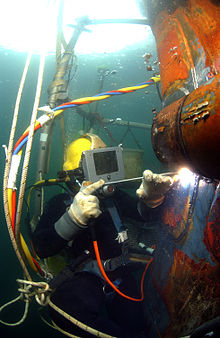 Professional diver using surface supplied diving equipment performing underwater welding
Professional diver using surface supplied diving equipment performing underwater welding See also: Recreational diving and Professional diving
See also: Recreational diving and Professional divingScuba diving may be performed for a number of reasons, both personal and professional. Most people begin[citation needed] through recreational diving, which is performed purely for enjoyment and has a number of distinct technical disciplines to increase interest underwater, such as cave diving, wreck diving, ice diving and deep diving.
Divers may be employed professionally to perform tasks underwater. Most of these commercial divers are employed to perform tasks related to the running of a business involving deep water, including civil engineering tasks such as in oil exploration, underwater welding or offshore construction. Commercial divers may also be employed to perform tasks specifically related to marine activities, such as naval diving, including the repair and inspection of boats and ships, salvage of wrecks or underwater fishing, like spear fishing.
Other specialist areas of diving include military diving, with a long history of military frogmen in various roles. They can perform roles including direct combat, infiltration behind enemy lines, placing mines or using a manned torpedo, bomb disposal or engineering operations. In civilian operations, many police forces operate police diving teams to perform search and recovery or search and rescue operations and to assist with the detection of crime which may involve bodies of water. In some cases diver rescue teams may also be part of a fire department, paramedical service or lifeguard unit, and may be classed as public service diving.
Lastly, there are professional divers involved with the water itself, such as underwater photography or underwater filming divers, who set out to document the underwater world, or scientific diving, including marine biology, geology, hydrology, oceanography and underwater archaeology.
Reasons for diving may include:
Type of diving Classification Aquarium maintenance in large public aquariums Commercial, scientific Boat and ship inspection, cleaning and maintenance Commercial, naval Cave diving Technical, recreational, scientific Civil engineering in harbors, water supply, and drainage systems Commercial Crude oil industry and other offshore construction and maintenance Commercial Demolition and salvage of ship wrecks Commercial, naval Diver training for reward Professional Fish farm maintenance Commercial Fishing, e.g. for abalones, crabs, lobsters, pearls, scallops, sea crayfish, sponges Commercial Frogman, manned torpedo Military Harbor clearance and maintenance Commercial, military Media diving: making television programs, etc. Professional Mine clearance and bomb disposal, disposing of unexploded ordnance Military, naval Pleasure, leisure, sport Recreational Policing: diving to investigate or arrest unauthorized divers Police diving, military, naval Search and recovery diving Commercial, Public service, Police diving Search and rescue diving Police, naval, Public service Spear fishing Professional (occasionally), recreational Stealthy infiltration Military Surveys and mapping Scientific, recreational Marine biology Scientific, recreational Underwater archaeology (shipwrecks; harbors, and buildings) Scientific, recreational Underwater inspections and surveys Commercial, military Underwater photography Professional, recreational Underwater tour guiding Professional, recreational Underwater tourism Recreational Underwater welding Commercial Breathing underwater
For more information, see Diving regulator.Water normally contains the dissolved oxygen from which fish and other aquatic animals extract all their required oxygen as the water flows past their gills. Humans lack gills and do not otherwise have the capacity to breathe underwater unaided by external devices.[3] Although the feasibility of filling and artificially ventilating the lungs with a dedicated liquid (liquid breathing) has been established for some time,[6] the size and complexity of the equipment allows only for medical applications with current technology.[7]
Early diving experimenters quickly discovered it is not enough simply to supply air to breathe comfortably underwater. As one descends, in addition to the normal atmospheric pressure, water exerts increasing pressure on the chest and lungs—approximately 1 bar (14.7 pounds per square inch) for every 33 feet (10 m) of depth—so the pressure of the inhaled breath must almost exactly counter the surrounding or ambient pressure to inflate the lungs. It generally becomes difficult to breathe through a tube past three feet under the water.[3]
By always providing the breathing gas at ambient pressure, modern demand valve regulators ensure the diver can inhale and exhale naturally and virtually effortlessly, regardless of depth.
Because the diver's nose and eyes are covered by a diving mask; the diver cannot breathe in through the nose, except when wearing a full face diving mask. However, inhaling from a regulator's mouthpiece becomes second nature very quickly.
Open-circuit regulator
The most commonly used scuba set today is the "single-hose" open circuit 2-stage diving regulator, coupled to a single pressurized gas cylinder, with the first stage on the cylinder and the second stage at the mouthpiece.[2] This arrangement differs from Emile Gagnan's and Jacques Cousteau's original 1942 "twin-hose" design, known as the Aqua-lung, in which the cylinder's pressure was reduced to ambient pressure in one or two or three[citation needed] stages which were all on the cylinder. The "single-hose" system has significant advantages over the original system.
In the "single-hose" two-stage design, the first stage regulator reduces the cylinder pressure of about 200 bar (3000 psi) to an intermediate level of about 10 bar (145 psi) above ambient pressure. The second stage demand valve regulator, connected via a low pressure hose to the first stage, delivers the breathing gas at the correct ambient pressure to the diver's mouth and lungs. The diver's exhaled gases are exhausted directly to the environment as waste. The first stage typically has at least one outlet delivering breathing gas at unreduced tank pressure. This is connected to the diver's pressure gauge or computer, in order to show how much breathing gas remains.
Rebreather
Further information: RebreatherLess common are closed (CCR) and semi-closed (SCR) rebreathers,[8] which unlike open-circuit sets that vent off all exhaled gases, reprocess each exhaled breath for re-use by removing the carbon dioxide buildup and replacing the oxygen used by the diver.
Rebreathers release few or no gas bubbles into the water, and use much less oxygen per hour because exhaled oxygen is recovered; this has advantages for research, military,[2] photography, and other applications. The first modern rebreather was the MK-19 that was developed at S-Tron by Ralph Osterhout that was the first electronic system.[citation needed] Rebreathers are more complex and more expensive than sport open-circuit scuba, and need special training and maintenance to be safely used due to the larger variety of potential failure modes.[8]
In a closed-circuit rebreather the oxygen partial pressure in the rebreather is controlled, so it can be increased to a safe continuous maximum, which reduces the inert gas (nitrogen and/or helium) partial pressure in the breathing loop. Minimising the inert gas loading of the diver's tissues for a given dive profile reduces the decompression obligation. This requires continuous monitoring of actual partial pressures with time and for maximum effectiveness requires real-time computer processing by the diver's decompression computer. Decompression can be much reduced compared to fixed ratio gas mixes used in other scuba systems and, as a result, divers can stay down longer. A semi-closed circuit rebreather injects a constant flow of a fixed nitrox mixture in the breathing loop, so the partial pressure of oxygen at any time during the dive depends on the diver's oxygen consumption. Planning decompression requirements requires a more conservative approach for a SCR than for a CCR.
Because rebreathers produce very few bubbles, they do not disturb marine life or make a diver’s presence known at the surface; this is useful for underwater photography, and for covert work.
Gas mixtures
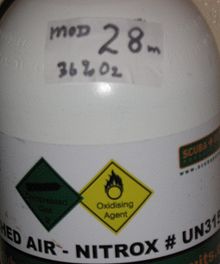 Nitrox cylinder marked up for use showing maximum safe operating depth (MOD)
Nitrox cylinder marked up for use showing maximum safe operating depth (MOD) Main article: Breathing gas
Main article: Breathing gasFor some diving, gas mixtures other than normal atmospheric air (21% oxygen, 78% nitrogen, 1% trace gases) can be used,[2][3] so long as the diver is properly trained in their use. The most commonly used mixture is Nitrox, also referred to as Enriched Air Nitrox (EAN), which is air with extra oxygen, often with 32% or 36% oxygen, and thus less nitrogen, reducing the likelihood of decompression sickness or allowing longer exposure to the same depth for equal risk. The reduced nitrogen may also allow for no stops or shorter decompression stop times and a shorter surface interval between dives. A common misconception is that nitrox can reduce narcosis, but research has shown that oxygen is also narcotic.[9][10]
Several other common gas mixtures are in use, and all need specialized training for safe use. The increased oxygen levels in nitrox help reduce the risk of decompression sickness; however, below the maximum operating depth of the mixture, the increased partial pressure of oxygen can lead to an unacceptable risk of oxygen toxicity. To displace nitrogen without the increased oxygen concentration, other diluents can be used, usually helium, when the resultant three gas mixture is called trimix, and when the nitrogen is fully substituted by helium, heliox.
For technical dives, some of the cylinders may contain different gas mixtures for the various phases of the dive, typically designated as Travel, Bottom, and Decompression gases. These different gas mixtures may be used to extend bottom time, reduce inert gas narcotic effects, and reduce decompression times.
Moving and seeing underwater
Refraction and underwater vision
Main article: Underwater visionWater has a higher refractive index than air; it's similar to that of the cornea of the eye. Light entering the cornea from water is hardly refracted at all, leaving only the eye's crystalline lens to focus light. This leads to very severe hypermetropia. People with severe myopia, therefore, can see better underwater without a mask than normal-sighted people.
Diving masks and diving helmets and fullface masks solve this problem by creating an air space in front of the diver's eyes.[2] The refraction error created by the water is mostly corrected as the light travels from water to air through a flat lens, except that objects appear approximately 34% bigger and 25% closer in salt water than they actually are. Therefore total field-of-view is significantly reduced and eye–hand coordination must be adjusted.
(This affects underwater photography: a camera seeing through a flat window in its casing is affected the same as its user's eye seeing through a flat mask window, and so its user must focus for the apparent distance to target, not for the real distance.)
Divers who need corrective lenses to see clearly outside the water would normally need the same prescription while wearing a mask. Generic and custom corrective lenses are available for some two-window masks. Custom lenses can be bonded onto masks that have a single front window.
A "double-dome mask" has curved windows in an attempt to cure these faults, but this causes a refraction problem of its own.
Commando frogmen concerned about revealing their position when light reflects from the glass surface of their diving masks may instead use special contact lenses to see underwater.
As a diver descends, he must periodically exhale through his nose to equalize the internal pressure of the mask with that of the surrounding water. Swimming goggles are not suitable for diving because they only cover the eyes and thus do not allow for equalization. Failure to equalise the pressure inside the mask may lead to a form of barotrauma known as mask squeeze.[2][11]
Light underwater
Water preferentially absorbs red light, and to a lesser extent, yellow and green light, so the color that is least absorbed by water is blue light.[12]
Table of Light Absorption in pure water Color Average wavelength Approximate depth of total absorption Ultraviolet 300 nm 25 m Violet 400 nm 100 m Blue 475 nm 275 m Green 525 nm 110 m Yellow 575 nm 50 m Orange 600 nm 20 m Red 685 nm 5 m Infra-red 800 nm 3 m Controlling buoyancy underwater
 Diver under the Salt Pier in Bonaire.
Diver under the Salt Pier in Bonaire.
To dive safely, divers must control their rate of descent and ascent in the water.[3] Ignoring other forces such as water currents and swimming, the diver's overall buoyancy determines whether he ascends or descends. Equipment such as diving weighting systems, diving suits (wet, dry or semi-dry suits are used depending on the water temperature) and buoyancy compensators can be used to adjust the overall buoyancy.[2] When divers want to remain at constant depth, they try to achieve neutral buoyancy. This minimizes gas consumption caused by swimming to maintain depth.
The downward force on the diver is the weight of the diver and his equipment minus the weight of the volume of the liquid that he and his equipment are displacing; if the result is negative, that force is upwards. The buoyancy of any object immersed in water is also affected by the density of the water. The density of fresh water is about 3% less than that of ocean water.[13] Therefore, divers who are neutrally buoyant at one dive destination (e.g. a fresh water lake) will predictably be positively or negatively buoyant when using the same equipment at destinations with different water densities (e.g. a tropical coral reef).
The removal ("ditching" or "shedding") of diver weighting systems can be used to reduce the diver's weight and cause a buoyant ascent in an emergency.
Diving suits made of compressible materials, decrease in volume as the diver descends, and expand again as the diver ascends, creating buoyancy changes. Diving in different environments also necessitates adjustments in the amount of weight carried to achieve neutral buoyancy. The diver can inject air into dry suits to counteract the compression effect and squeeze. Buoyancy compensators allow easy and fine adjustments in the diver's overall volume and therefore buoyancy. For open circuit divers, changes in the diver's lung volume can be used to make fine adjustments of buoyancy.
Neutral buoyancy in a diver is a metastable state. It is changed by small differences in ambient pressure caused by a chandge in depth, and the change has a positive feedback effect. A small descent will increase the pressure, which will compress the gas filled spaces and reduce the total volume of diver and equipment. This will further reduce the buoyancy, and unless counteracted, will result in sinking more rapidly. The equivalent effect applies to a small ascent, which will trigger an increased buoyancy and will result in accelerated ascent unless counteracted. The diver must continuously adjust buoyancy or depth in order to remain neutral. This is a skill which improves with practice.
Being mobile underwater
The diver needs to be mobile underwater. Streamlining dive gear will reduce drag and improve mobility. Personal mobility is enhanced by swimfins and Diver Propulsion Vehicles. Other equipment to improve mobility includes diving bells and diving shots.
Underwater communication
 Two divers giving the sign that they are "OK" on a wreck in the Dominican Republic.
Two divers giving the sign that they are "OK" on a wreck in the Dominican Republic.
A diver cannot talk underwater unless he is wearing a full-face mask, but divers can communicate, using hand signals. It is said
that if a diver "signals to his buddy regularly during a dive, this will ensure that they remain in close contact and that they can easily notify each other in case problems occur."; a diver should repeat any sign that is not clear to his buddy, and acknowledge every signal that he or she makes with an "OK" signal to show that he understands.[14]
Table of Hand Signals
No. Signal Meaning Comment 1. Hand raised, fingers pointed up, palm to receiver. STOP Transmitted in the same way as a traffic police officer’s STOP 2. Thumb extended downward from clenched fist. GO DOWN or GOING DOWN 3. Thumb extended upward from clenched fist. GO UP or GOING UP 4. Thumb and forefinger making a circle with three remaining fingers extended (if possible). OK! or OK? Divers wearing mittens may not be able to extend 3 remaining fingers distinctly. 5. Two arms extended overhead with finger tips touching above head to make a large O shape. OK! or OK? A diver with only one free arm may make this signal by extending that arm overhead with finger tips touching top of head to make the O shape. Signal is for long-range use. 6. Hand flat, fingers together, palm down, thumb sticking out, then hand rocking back and forth on axis of forearm. SOMETHING IS WRONG This is the opposite of OK! The signal does not indicate emergency. 7. Hand waving over head (may also thrash hand on water). DISTRESS Indicates immediate aid required. 8. Fist pounding on chest. LOW ON AIR Indicates signaler's air supply is reduced. 9. Hand slashing or chopping throat. OUT OF AIR Indicates that the signaler cannot breathe. 10. Clenched fist on arm extended in direction of danger. DANGER All signals are to be answered by the receivers repeating the signal as sent. When answering signals 7 & 9, the receiver should approach to offer aid to signaler.(Miller 6.11)[15]
Hazards and dangers
According to a 1970 North American study, diving was (on a man-hours based criteria) 96 times more dangerous than driving an automobile.[16] According to a 2000 Japanese study, every hour of recreational diving is 36 to 62 times riskier than automobile driving.[17] A big difference between the risks of driving and diving is that the diver is less at risk from fellow divers than the driver is from other drivers.
Injuries due to changes in pressure
For a full list, see Diving hazards and precautions.Divers must avoid injuries caused by changes in air pressure. The weight of the water column above the diver causes an increase in pressure in proportion to depth, in the same way that the weight of the column of atmospheric air above the surface causes a pressure of 101.3 kPa (14.7 pounds-force per square inch) at sea level. This variation of pressure with depth will cause compressible materials and gas filled spaces to tend to change volume, which can cause the surrounding material or tissues to be stressed, with the risk of injury if the stress gets too high. Pressure injuries are called barotrauma[3] and can be quite painful, even potentially fatal - in severe cases causing a ruptured lung, eardrum or damage to the sinuses. To avoid barotrauma, the diver equalizes the pressure in all air spaces with the surrounding water pressure when changing depth. The middle ear and sinus are equalized using one or more of several techniques, which is referred to as clearing the ears.
The scuba mask (half-mask) is equalized during descent by periodically exhaling through the nose. During ascent it will automatically equalise by leaking excess air round the edges. A helmet or full face mask will automatically equalise as any pressure differential will either vent through the exhaust valve or open the demand valve and release air into the low pressure space. A more serious hazard with surface supplied helmet is a break in the supply hose at a shallower depth then the diver at the same time as a non-return valve failure at the helmet inlet. On a helmet with a neck dam, the pressure difference will cause the helmet to flood past the neck dam, but on a helmet sealed to the suit a helmet squeeze will result which can cause serious, possibly fatal injury.[18]
If a drysuit is worn, it must be equalized by inflation and deflation, much like a buoyancy compensator. Most dry suits are fitted with an auto-dump valve, which, if set correctly, and kept at the high point of the diver by good trim skills, will automatically release gas as it expands and retain a virtually constant volume during ascent. The buoyancy compensator will not have the automatic dumping characteristic and must be manually vented during ascent to retain correct volume for a controlled ascent rate, During descent both dry suit and buoyancy compensator must be inflated manually.
Although there are many dangers involved in scuba diving, divers can decrease the risks through proper procedures and appropriate equipment. The requisite skills are acquired by training and education, and honed by practice. Open-water certification programs highlight diving physiology, safe diving practices, and diving hazards, but do not provide sufficient practice to become truly adept.
Effects of breathing high pressure gas
Decompression sickness
Main article: Decompression sicknessThe prolonged exposure to breathing gases at high partial pressure will result in increased amounts of non-metabolic gases, usually nitrogen and/or helium, (referred to in this context as inert gases) dissolving in the bloodstream as it passes through the alveolar capillaries, and thence carried to the other tissues of the body, where they will accumulate until saturated. This saturation process has very little immediate effect on the diver. However when the pressure is reduced during ascent, the amount of dissolved inert gas that can be held in stable solution in the tissues is reduced. This effect is described by Henry's Law.
As a consequence of the reducing partial pressure of inert gases in the lungs during ascent, the dissolved gas will be diffused back from the bloodstream to the gas in the lungs and exhaled. The reduced gas concentration in the blood has a similar effect when it passes through tissues carrying a higher concentration, and that gas will diffuse back into the bloodsteam, reducing the loading of the tissues.
As long as this process is gradual, all will go well and the diver will reduce the gas loading by diffusion and perfusion until it eventually re-stabilises at the current saturation pressure. The problem arises when the pressure is reduced more quickly than the gas can be removed by this mechanism, and the level of supersaturation rises sufficiently to become unstable. At this point, bubbles may form and grow in the tissues, and may cause damage either by distending the tissue locally, or blocking small blood vessels, shutting off blood supply to the downstream side, and resulting in hypoxia of those tissues.
This effect is called decompression sickness[3] or 'the bends', and must be avoided by reducing the pressure on the body slowly while ascending and allowing the inert gases dissolved in the tissues to be eliminated while still in solution. This process is known as "off-gassing", and is done by restricting the ascent (decompression) rate to one where the level of supersaturation is not sufficient for bubbles to form. This is done by controlling the speed of ascent and making periodic stops to allow gases to be eliminated. The procedure of making stops is called staged decompression, and the stops are called decompression stops. Decompression stops that are not computed as strictly necessary are called safety stops, and reduce the risk of bubble formation further. Dive computers or decompression tables are used to determine a relatively safe ascent profile, but are not completely reliable. There remains a statistical possibility of decompression bubbles forming even when the guidance from tables or computer has been followed exactly.
Decompression sickness must be treated as soon as practicable. Definitive treatment is usually recompression in a recompression chamber with hyperbaric oxygen treatment. Exact details will depend on severity and type of symptoms, response to treatment, and the dive history of the casualty. Administering enriched-oxygen breathing gas or pure oxygen to a decompression sickness stricken diver on the surface is a good form of first aid for decompression sickness, although death or permanent disability may still occur.[19]
Nitrogen narcosis
Main article: Nitrogen narcosisNitrogen narcosis or inert gas narcosis is a reversible alteration in consciousness producing a state similar to alcohol intoxication in divers who breathe high pressure gas at depth.[3] The mechanism is similar to that of nitrous oxide, or "laughing gas," administered as anesthesia. Being "narced" can impair judgment and make diving very dangerous. Narcosis starts to affect some divers at 66 feet (20 m). At this depth, narcosis manifests itself as a slight giddiness. The effects increase drastically with the increase in depth. Almost all divers are able to notice the effects by 132 feet (40 meters). At these depths divers may feel euphoria, anxiety, loss of coordination and lack of concentration. At extreme depths, hallucinogenic reaction and tunnel vision can occur. Jacques Cousteau famously described it as the "rapture of the deep". Nitrogen narcosis occurs quickly and the symptoms typically disappear during the ascent, so that divers often fail to realize they were ever affected. It affects individual divers at varying depths and conditions, and can even vary from dive to dive under identical conditions. However, diving with trimix or heliox dramatically reduces the effects of inert gas narcosis.
Oxygen toxicity
Main article: Oxygen toxicityOxygen toxicity occurs when oxygen in the body exceeds a safe "partial pressure" (PPO2).[3] In extreme cases it affects the central nervous system and causes a seizure, which can result in the diver spitting out his regulator and drowning. Oxygen toxicity is preventable provided one never exceeds the established maximum depth of a given breathing gas. For deep dives—generally past 180 feet (55 m), divers use "hypoxic blends" containing a lower percentage of oxygen than atmospheric air. For more information, see oxygen toxicity.
Avoiding losing body heat
Main article: Diving suitWater conducts heat from the diver 25 times[20] better than air, which can lead to hypothermia even in mild water temperatures.[3] Symptoms of hypothermia include impaired judgment and dexterity,[21] which can quickly become deadly in an aquatic environment. In all but the warmest waters, divers need the thermal insulation provided by wetsuits or drysuits.[2]
In the case of a wetsuit, the suit is designed to minimize heat loss. Wetsuits are usually made of neoprene that has small closed gas cells, generally nitrogen, trapped in it during the manufacturing process. The poor thermal conductivity of this expanded cell neoprene means that wetsuits reduce loss of body heat by conduction to the surrounding water. The neoprene, and to a larger extent the nitrogen gas, in this case acts as an insulator. The effectiveness of the insulation is reduced when the suit is compressed due to depth, as the nitrogen filled bubbles are then smaller and conduct heat better.
The second way in which wetsuits reduce heat loss is to trap a thin layer of water between the diver's skin and the insulating suit itself. Body heat then heats the trapped water. Provided the wetsuit is reasonably well-sealed at all openings (neck, wrists, ankles zippers and overlaps with other suit components), this reduces flow of cold water over the surface of the skin, and thereby reduces loss of body heat by convection, which helps keep the diver warm (this is the principle employed in the use of a "Semi-Dry" wetsuit)
In the case of a drysuit, it does exactly what the name implies: keeps a diver dry. The suit is waterproof and sealed so that frigid water cannot penetrate the suit. Drysuit undergarments are usually worn under a drysuit to keep a layer of air inside the suit for better thermal insulation. Some divers carry an extra gas bottle dedicated to filling the dry suit. Usually this bottle contains argon gas, because of its better insulation as compared with air.[22] Dry suits should not be inflated with gases containing helium as it is a good thermal conductor.
Drysuits fall into two main categories: neoprene and membrane; both systems have their good and bad points but generally their thermal properties can be reduced to:
- Membrane or Shell drysuits: usually a trilaminate construction; owing to the thinness of the material (around 1 mm), these require an undersuit, usually of high insulation value if diving in cooler water.
- Neoprene drysuits: a similar construction to wetsuits; these are often considerably thicker (7–8 mm) and have sufficient insulation to allow a lighter-weight undersuit (or none at all); however on deeper dives the neoprene can compress to as little as 2 mm thus losing a proportion of its insulation. Compressed or crushed neoprene may also be used (where the neoprene is pre-compressed to 2–3 mm) which avoids the variation of insulating properties with depth. These drysuits function more like a membrane suit.
Avoiding skin cuts and grazes
Diving suits also help prevent the diver's skin being damaged by rough or sharp underwater objects, marine animals, coral, or metal debris commonly found on shipwrecks.
Diving longer and deeper safely
There are a number of techniques to increase the diver's ability to dive deeper and longer:
- Technical diving – diving deeper than 40 metres (130 ft), using mixed gases, and/or entering overhead environments (caves or wrecks)
- Surface supplied diving – use of umbilical gas supply and diving helmets.[2]
- Saturation diving – long-term use of underwater habitats under pressure and a gradual release of pressure over several days in a decompression chamber at the end of a dive.[2]
Scuba diver training and certification agencies
Main article: List of diver training organizationsDiving lessons in Monterey Bay, California
Recreational scuba diving does not have a centralized certifying or regulatory agency, and is mostly self regulated. There are, however, several large diving organizations that train and certify divers and dive instructors, and many diving related sales and rental outlets require proof of diver certification from one of these organizations prior to selling or renting certain diving products or services.
The largest international certification agencies that are currently recognized by most diving outlets for diver certification include:
- American Canadian Underwater Certifications (ACUC) (formerly Association of Canadian Underwater Councils) – originated in Canada in 1969 and expanded internationally in 1984
- British Sub Aqua Club (BSAC) – based in the United Kingdom, founded in 1953 and is the largest dive club in the world
- European Committee of Professional Diving Instructors (CEDIP) based in Europe since 1992 (see Cedip on French Wiki pages)
- Confédération Mondiale des Activités Subaquatiques (CMAS), the World Underwater Federation
- National Association of Underwater Instructors (NAUI) – based in the United States
- Professional Diving Instructors Corporation (PDIC) – based in the United States
- Professional Association of Diving Instructors (PADI) – based in the United States, largest recreational dive training and certification organization in the world
- Scottish Sub Aqua Club (SSAC or ScotSAC) the National Governing Body for the sport of diving in Scotland.
- International Training SDI, TDI & ERDi - based in the United States, TDI is the world's largest technical diving agency, SDI is the recreational division focusing on new methods and online courses, and ERDi is the public safety component.
- Scuba Schools International (SSI) – based in the United States with 35 Regional Centers and Area Offices around the globe.
- YMCA Scuba – based in the United States, provided by Young Men's Christian Association (YMCA); discontinued after 2008.
See also
- Altitude diving
- Aqualung, a type of breathing set
- Aquanaut
- Artificial gills (human)
- Barodontalgia
- Barotrauma
- British Sub-Aqua Club
- Decompression sickness
- Diver training
- Divers Alert Network (DAN)
- Diving equipment
- Diving hazards and precautions
- Diving physics
- Diving signal
- Diving suit
- Drift diving
- Engineer Diver
- See Frogman#Mistakes in fiction for common mistakes in depicting scuba gear.
- Green Fins
- Like-A-Fish, a breathing set that extracts oxygen from surrounding water
- scuba diving quarry
- Sea Hunt, a television fiction series about scuba diving
- Sea Trek
- Snorkeling
- Snuba
- Technical diving
- Timeline of underwater technology
- Underwater diving
- Underwater photography
- Underwater videography
- Wreck diving
Reference list
- ^ "Compact Oxford English Dictionary - scuba". Oxford University Press. http://www.askoxford.com/concise_oed/scuba?view=uk.
- ^ a b c d e f g h i j US Navy Diving Manual, 6th revision. United States: US Naval Sea Systems Command. 2006. http://www.supsalv.org/00c3_publications.asp?destPage=00c3&pageID=3.9. Retrieved April 24, 2008.
- ^ a b c d e f g h i j k Brubakk, Alf O; Neuman, Tom S (2003). Bennett and Elliott's physiology and medicine of diving, 5th Rev ed. United States: Saunders Ltd. p. 800. ISBN 0702025712.
- ^ Vann RD (2004). "Lambertsen and O2: beginnings of operational physiology". Undersea Hyperb Med 31 (1): 21–31. PMID 15233157. http://archive.rubicon-foundation.org/3987. Retrieved April 25, 2008.
- ^ Butler FK (2004). "Closed-circuit oxygen diving in the U.S. Navy". Undersea Hyperb Med 31 (1): 3–20. PMID 15233156. http://archive.rubicon-foundation.org/3986. Retrieved April 25, 2008.
- ^ Hirschl, RB; et al (1995). "Liquid ventilatory in adults, children, and full-term neonates". Lancet 346 (8984): 1201–1202. doi:10.1016/S0140-6736(95)92903-7. PMID 7475663.
- ^ Sekins, KM; et al (1999). "Recent innovation in total liquid ventilation system and component design". Biomedical instrumentation and technology 33 (3): 277–284. PMID 10360218.
- ^ a b Richardson, D; Menduno, M; Shreeves, K. (eds). (1996). "Proceedings of Rebreather Forum 2.0.". Diving Science and Technology Workshop.: 286. http://archive.rubicon-foundation.org/7555. Retrieved August 20, 2008.
- ^ Hesser, CM; Fagraeus, L; Adolfson, J (1978). "Roles of nitrogen, oxygen, and carbon dioxide in compressed-air narcosis.". Undersea Biomed. Res. 5 (4): 391–400. ISSN 0093-5387. OCLC 2068005. PMID 734806. http://archive.rubicon-foundation.org/2810. Retrieved April 8, 2008.
- ^ Brubakk, Alf O; Neuman, Tom S (2003). Bennett and Elliott's physiology and medicine of diving, 5th Rev ed. United States: Saunders Ltd. p. 304. ISBN 0702025712.
- ^ NOAA Diving Manual, 4th Edition, Best Publishing, 2001
- ^ Hegde, M (30 September 2009). "The Blue, the Bluer, and the Bluest Ocean". NASA Goddard Earth Sciences Data and Information Services. http://disc.sci.gsfc.nasa.gov/oceancolor/additional/science-focus/ocean-color/oceanblue.shtml. Retrieved 27 May 2011.
- ^ Elert, Glenn (2002). "Density of Seawater". The Physics Factbook. http://hypertextbook.com/facts/2002/EdwardLaValley.shtml. Retrieved April 16, 2010.
- ^ GULLIVER. "Scuba Diving Hand Signals." Scuba Diving. http://www.dailyscubadiving.com, 23 Jan 2010. Web. 1 Dec 2010. http://www.dailyscubadiving.com/scuba-diving-hand-signals/
- ^ Miller, James W. NOAA Diving Manual Diving for Science and Technology. 2nd ed. Washington, D.C.: U.S. Government Printing Office, 1979. 6.11.
- ^ Deaths During Skin and Scuba Diving in California in 1970
- ^ Is recreational diving safe?, por Ikeda, T y Ashida, H
- ^ Steven M. Barsky, Tom S. Neuman (2003); Investigating Recreational and Commercial Diving Accidents, Hammerhead press, California.
- ^ Longphre, J. M.; P. J. DeNoble; R. E. Moon; R. D. Vann; J. J. Freiberger (2007). "First aid normobaric oxygen for the treatment of recreational diving injuries". Undersea Hyperb Med. 34 (1): 43–49. ISSN 1066-2936. OCLC 26915585. PMID 17393938. http://archive.rubicon-foundation.org/5514. Retrieved May 3, 2008.
- ^ "Thermal Conductivity", Georgia State University, accessed February 15, 2008
- ^ Weinberg, R. P.; E. D. Thalmann. (1990). "Effects of Hand and Foot Heating on Diver Thermal Balance". Naval Medical Research Institute Report 90-52. http://archive.rubicon-foundation.org/4247. Retrieved May 3, 2008.
- ^ Nuckols ML, Giblo J, Wood-Putnam JL. (September 15–18, 2008). "Thermal Characteristics of Diving Garments When Using Argon as a Suit Inflation Gas.". Proceedings of the Oceans 08 MTS/IEEE Quebec, Canada Meeting (MTS/IEEE). http://archive.rubicon-foundation.org/7962. Retrieved April 17, 2009.
Further reading
- Books published by the British Sub-Aqua Club:
- The Diving Manual, BSAC, ISBN 0-9538919-2-5
- Dive Leading, BSAC, ISBN 0-9538919-4-1
- The Club 1953-2003, BSAC, ISBN 0-9538919-5-X
- Free Scuba textbook by George D. Campbell, III called Diving With Deep-Six
External links
- Divers Alert Network—Diving Emergencies/Hyperbaric Chamber Assistance
- Scuba diving travel guide from Wikitravel
Underwater diving Types: 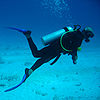
Specialities: Equipment: Disciplines: Professional diving · Police diving · Military diving · Underwater photography · Underwater videographyHazards: Related: Categories:- Underwater diving
- Mixed sports
Wikimedia Foundation. 2010.

